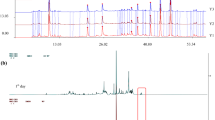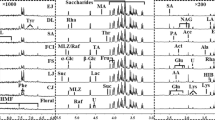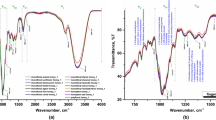Abstract
The botanical origin of honey is subjected to severe controls by Food Control Institutions, both for health protection and for frauds prevention. The complexity of honey makes it very difficult to verify the botanical origin. Among the available validated methods, sensory analysis and melissopalynology are the most widely employed. These methods require a long time and deep consolidated expertise. To shorten analysis time while simplifying the analytical procedure, head-space flash gas chromatography was applied in the present study. Chromatographic peak areas were processed by chemometrics (in particular principal components analysis and linear discriminant analysis). Three hundred and thirty-nine honey samples from twelve categories of unifloral honey were analyzed: acacia, citrus, chestnut, thistle, tree heath, eucalyptus, sunflower, rhododendron, lime, French honeysuckle, fir honeydew, and wood honeydew. Each sample was a priori classified by sensory analysis. The multivariate models were validated by cross validation and test-set validation, with predictive abilities always higher than 80%: good results were obtained both in calibration and in prediction mode, showing a good agreement between this new approach and the traditional one for the determination of the botanical origin of honey.



Similar content being viewed by others
References
Codex Alimentarius (2001) Revised codex standard for honey, standards and standard methods. Codex Aliment Comm FAO/OMS 11:7
Directive 110/2001 EU (2002) Council directive 2001/110/EC relating to honey. Official Journal of the European Communities, pp 10–47
Moore JC, Spink J, Lipp M (2012) Development and application of a database of food ingredient fraud and economically motivated adulteration from 1980 to 2010. J Food Sci 77:R118–R126
Sabatini AG, Bortolotti L, Marcazzan GL (2007) Conoscere il miele. Edizioni Avenue Media, Bologna-Milano, Italy
Martin P (2005) Importance of melissopalynology for beekeeping and trade. Bee World 86:75–76. https://doi.org/10.1080/0005772X.2005.11417317
Karabagias IK, Badeka AV, Kontakos S et al (2014) Botanical discrimination of Greek unifloral honeys with physico-chemical and chemometric analyses. Food Chem 165:181–190. https://doi.org/10.1016/j.foodchem.2014.05.033
Alissandrakis E, Tarantilis PA, Harizanis PC, Polissiou M (2007) Comparison of the volatile composition in thyme honeys from several origins in Greece. J Agric Food Chem 55:8152–8157. https://doi.org/10.1021/jf071442y
Molan PC (1998) The limitations of the methods of identifying the floral source of honeys. Bee World 79:59–68. https://doi.org/10.1080/0005772X.1998.11099381
Piana M, Oddo L, Bentabol A, Bruneau E, Stefan Bogdanov CD (2004) Sensory analysis applied to honey:state of art. Apidologie 37:275–292. https://doi.org/10.1051/apido
Davies AMC, Radovic B, Fearn T, Anklam E (2002) A preliminary study on the characterisation of honey by near infrared spectroscopy. J Near Infrared Spectrosc 10:121–135. https://doi.org/10.1255/jnirs.329
Corvucci F, Nobili L, Melucci D, Grillenzoni FV (2015) The discrimination of honey origin using melissopalynology and Raman spectroscopy techniques coupled with multivariate analysis. Food Chem 169:297–304. https://doi.org/10.1016/j.foodchem.2014.07.122
Escriche I, Kadar M, Domenech E, Gil-Sánchez L (2012) A potentiometric electronic tongue for the discrimination of honey according to the botanical origin. Comparison with traditional methodologies: physicochemical parameters and volatile profile. J Food Eng 109:449–456. https://doi.org/10.1016/j.jfoodeng.2011.10.036
Ampuero S, Bogdanov S, Bosset JO (2004) Classification of unifloral honeys with an MS-based electronic nose using different sampling modes: SHS, SPME and INDEX. Eur Food Res Technol 218:198–207. https://doi.org/10.1007/s00217-003-0834-9
Revell LE, Morris B, Manley-Harris M (2014) Analysis of volatile compounds in New Zealand unifloral honeys by SPME-GC-MS and chemometric-based classification of floral source. J Food Meas Charact 8:81–91. https://doi.org/10.1007/s11694-013-9167-y
Piasenzotto L, Gracco L, Conte L (2003) Solid phase microextraction (SPME) applied to honey quality control. J Sci Food Agric 83:1037–1044. https://doi.org/10.1002/jsfa.1502
Verzera A, Condurso C (2012) Sampling techniques for the determination of the volatile fraction of honey. In: Pawliszyn J (ed) Comprehensive sampling and sample preparation, vol 4. Elsevier, Amsterdam, pp 87–117 . https://doi.org/10.1016/B978-0-12-381373-2.00129-0
Radovic BS, Careri M, Mangia A et al (2001) Contribution of dynamic headspace GC-MS analysis of aroma compounds to authenticity testing of honey. Food Chem 72:511–520. https://doi.org/10.1016/S0308-8146(00)00263-6
Kumar N, Bansal A, Sarma GS, Rawal RK (2014) Chemometrics tools used in analytical chemistry: an overview. Talanta 123:186–199
Peng Q, Tian R, Chen F et al (2015) Discrimination of producing area of Chinese Tongshan kaoliang spirit using electronic nose sensing characteristics combined with the chemometrics methods. Food Chem 178:301–305. https://doi.org/10.1016/j.foodchem.2015.01.023
Melucci D, Bendini A, Tesini F et al (2016) Rapid direct analysis to discriminate geographic origin of extra virgin olive oils by flash gas chromatography electronic nose and chemometrics. Food Chem. https://doi.org/10.1016/j.foodchem.2016.02.131
Bogdanov S (1997) Harmonized methods of the international honey comission. Swiss Bee Res Centre Bern, Switz
Aelst S, Van Willems G (2013) Fast and robust bootstrap for multivariate inference: the R Package FRB. J Stat Softw 53:1–32. https://doi.org/10.18637/jss.v053.i03
McLachlan GJ (2004) Discriminant analysis and statistical pattern recognition. Wiley series in probability and statistics, New York
Stone M (1974) Cross-validatory choice and assessment of statistical predictions. J R Stat Soc 36:111–147. https://doi.org/10.2307/2984809
Todeschini R (1998) Introduzione alla chemiometria. EdiSES, Naples, Italy
Venables WN, Ripley BD (2002) Modern applied statistics with S, 4th edn. Springer, New York. https://doi.org/10.2307/2685660
Riedl J, Esslinger S, Fauhl-Hassek C (2015) Review of validation and reporting of non-targeted fingerprinting approaches for food authentication. Anal Chim Acta 885:17–32
Acknowledgements
Authors would like to thank Fernando Gottardi, supervisor of the Sensory Area of COOP Italia laboratory, for its essential technical support during the GC analyses execution. We also would like to thank the National Honey Observatory (Osservatorio Nazionale Miele) and the Italian Consortium for Organic Productions (CIBI), honey contest organizers of “Grandi mieli d’Italia—Tre gocce d’oro—Premio Giulio Piana” and the international organic honey competition “BIOLMIEL”, respectively, for providing us with a selection of high quality honey samples. We sincerely thank them. Investigation supported by University of Bologna (Funds for Selected Research Topics).
Author information
Authors and Affiliations
Corresponding author
Ethics declarations
Conflict of interest
Authors declare no conflict of interest associated with this publication.
Compliance with ethics requirements
This article does not contain any studies with human participants or animals performed by any of the authors.
Rights and permissions
About this article
Cite this article
Zappi, A., Melucci, D., Scaramagli, S. et al. Botanical traceability of unifloral honeys by chemometrics based on head-space gas chromatography. Eur Food Res Technol 244, 2149–2157 (2018). https://doi.org/10.1007/s00217-018-3123-3
Received:
Revised:
Accepted:
Published:
Issue Date:
DOI: https://doi.org/10.1007/s00217-018-3123-3




